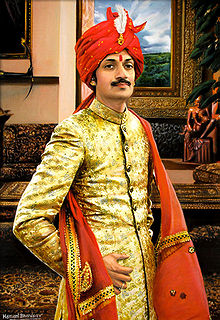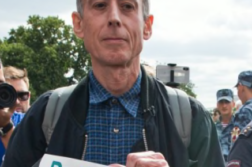 HE IS Yuvraj Shri Manvendra Singh Raghubir Singhji Sahib, also known by such other names as Manvendra Singh Gohil, or Manvendra Gohil, the prince of the Rajpipla state and heir to the throne, scion of a dynasty dating back 650 years. He was born in Ajmer, India, on September 23, 1965, son of Maharana Shri Raghubir Singhji Rajendrasinghji Sahib, who has been Maharaja of Rajpipla since 1963. Prince Manvendra received traditional and conservative teaching, and was educated at Bombay Scottish School and at Amrutben University Jivanlal College of Commerce and Economics, Vile Parle, Bombay. In 2006, he became the most visible and highly placed individual to come out publicly as gay in Indian history.
HE IS Yuvraj Shri Manvendra Singh Raghubir Singhji Sahib, also known by such other names as Manvendra Singh Gohil, or Manvendra Gohil, the prince of the Rajpipla state and heir to the throne, scion of a dynasty dating back 650 years. He was born in Ajmer, India, on September 23, 1965, son of Maharana Shri Raghubir Singhji Rajendrasinghji Sahib, who has been Maharaja of Rajpipla since 1963. Prince Manvendra received traditional and conservative teaching, and was educated at Bombay Scottish School and at Amrutben University Jivanlal College of Commerce and Economics, Vile Parle, Bombay. In 2006, he became the most visible and highly placed individual to come out publicly as gay in Indian history.
By the age of twelve, the Hindu prince—let us call him Gohil—already had a real awareness that he was attracted to other males, but he had no concept of homosexuality or gay identity. At the age of 26, he married Princess Yuvrani Chandrika Kumari of Jhabua in the administrative district of the state of Madhya Pradesh. Of that marriage, the prince later stated, addressing his spouse: “I thought that after marriage I would be well, because I never knew and nobody told me that I was gay and [that]that is normal. Homosexuality is not a disease. I am very sorry to have ruined your life. I feel guilty.” The marriage ended in divorce. After that, Gohil felt a deep repentance for the pain he had caused by embarking on a marriage that, in addition to being false, was never consummated.
In 2000, he created Lakshya Trust, a group dedicated to AIDS education and prevention. The organization is a public charitable foundation that works mainly among men who have sex with men. Lakshya Trust is known for providing psychological counseling services, clinics for the treatment of sexually transmitted diseases, and promotion of the use of condoms. In addition, the foundation seeks to secure employment opportunities for gays and supports other homosexual organizations. The foundation won the Civil Society Award from unaids in 2006 for its work on AIDS prevention among homosexual men.
In 2002, the Prince’s family heard about his sexual orientation after he was hospitalized with a nervous breakdown. Apparently he had been debating telling them the truth, and at this point he felt he could no longer hide it. “It was hard being gay in my family. The people adore us and we are role models for them. My family did not allow us to mix with ordinary people or the low castes. Our contact with the liberal world was minimal,” Gohil said.
When he came out publicly in March 2006, it was big news in India. “All this news of my homosexuality was like an earthquake,” he reported later. “The news spread like gunpowder and there was total chaos. People were confused.” His family accused him of dishonoring the dynasty and disinherited him. Numerous banners with the effigy of the prince were burned in Rajpipla, and some people called for the prince to be stripped of his titles. Later, his father forgave him, admitting him back into the family and giving his titles back. “My parents also realized that they had made a mistake by not accepting me, that same year they accepted me back,” he said.
Against this backdrop came a ruling by the Supreme Court of New Delhi on July 2, 2009, that repealed the infamous section 377 of the Penal Code, a leftover from the British Raj that illegalized homosexual acts. According to the court, consensual homosexual relations between two adults were no longer illegal in India. In that ruling, the judges said that homosexuals should be integrated into society and accorded dignity and respect.
Since coming out, Gohil has appeared on various TV programs, such as Oprah Winfrey, to address LGTB issues in India and in general. In January 2008, while he was holding an annual ceremony in Rajpipla in honor of his great-grandfather Vijay Singh Gohil, the Prince announced his plans to adopt a child.
On December 11, 2013, the Supreme Court of India ruled against the decriminalization of homosexual relationships as decided by the Delhi high court in July 2009. The Supreme Court ruled that the Delhi Court had overstepped its jurisdiction, maintaining that it was up to the legislature to repeal section 377. Consequently, homosexual relationships are again punishable in India with up to ten years’ imprisonment.
With legislative procedures in deadlock, the only hope at the moment is with the judicial branch. A few months ago, we learned that the Supreme Court had admitted an appeal filed in 2014, so that the decision to maintain the criminalization of homosexuality was reviewed by a panel of five judges of the Court. The applicants submitted that serious errors of form and substance were made in the 2013 ruling. Following the decision, the applicants may present their arguments to the court, which will have to decide definitively on the matter.
Naveen Kapoor is a freelance writer, blogger, and social media enthusiast from India.





Discussion1 Comment
I have made 17 visits to India and written 20 published articles about this astounding place. Each visit was for about 3 months and included most parts of India. Stirred by my experiences, I wrote Expect the Unexpected which covered the first six years of my visits as a Westerner sitting in the lap of Mother India.
When I began lecturing about India, I published India: Paradox & Treasures, volume one and two. This was a keep sake reminder for those attending my talks. Also, I made a compendium of selected photos of mine into a limited edition portfolio: Ganesha & Friends.
As a gay man, I was apprehensive as to how I would manage alone traversing this challenging and mysterious India. Those fears were soon dispelled as I found plentiful, desirable company. After the first two years, a young, handsome driver appeared who was to become my constant companion for the next ten years. He did everything to make my life easier and pleasant. We openly lived as a couple, seemingly respected by the communities we lived in.
As all fairy tales have an ending, my trips to India became increasingly difficult. Also, I wanted my young partner to discover more of life. He was a virgin when I met him, and it was now time for him to develop his own path. My thoughts are often about India; she made lasting impressions upon me and gave me a better perspective about what has been called the Human Comedy.